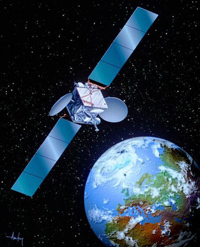Having picked up Nicholas Negroponte's speech at the AMD Global Vision conference, we were struck by his reported assertion that the cost of a laptop's "connection charges" would be as low as $1 per child per year. If this figure represented bandwidth costs, we wondered how it could be so low. Today, it looks like we might have part of our answer; SES Global, one of the world's largest satellite services companies, announced that they will join OLPC as corporate partners.
According to today's press release, SES Global will be donating $2 million dollars to OLPC as well as technical know how and — more importantly — bandwidth via their satellite network:
As new corporate partners of the project, SES ASTRA and SES AMERICOM will contribute important know-how for the conceptual development, give financial support of US$ 2 million and provide space capacity on SES' global satellite fleet to countries and organizations. The conceptual contribution includes the development of a "one dish per village" model, whereby the low-cost laptops with a wireless connection receive data from local hubs connected via satellite. The price of such laptops is expected to be around USD 100.An interesting point to note here is the apparent expansion of OLPC's original mission — to provide "a laptop for every child". It seems apparent that the scope may no longer be limited merely to laptops; there will be "One Server per School" and now "One Satellite Dish per Village" too. Here's hoping that the "One Dish Per Village" network will be available to the community as a whole — not just to children.



I think this is a propaganda stunt. No satellite company will give away so much bandwidth. Unless they are trying to get countries addicted to the bandwidth. Then sell access at high prices.
SES-Americom is connecting OLPC, starting with the Cambridge office:
SES-Americom has given us a two-way satellite terminal. The installation was completed this week at the roof of the Media Lab and the terminal is now connected to the OLPC offices via a Motorola canopy base station that sits on the top of MIT’s Eastgate building.
In this manner we are now able to setup a simulation of a complete rural school network at the OLPC Cambridge office and test network connectivity via satellite.
The system that SES has given us is an iDirect series 5000, which is towards the high-end of the spectrum as far as VSAT routers go and is able to sustain 500Kbps symmetric with download bursts up to 6Mbps.
http://lists.laptop.org/pipermail/community-news/2007-October/000081.html
This is an excellent article global satellite. However,
satellite DSL should be considered as an alternative,
particulary in rural areas without regular DSL or cable internet access.
http://www.1-satellite-tv-facts.com/Satellite-DSL.html